Bio II Unit 1 Learning Catalytics
1/39
Earn XP
Name | Mastery | Learn | Test | Matching | Spaced |
|---|
No study sessions yet.
40 Terms
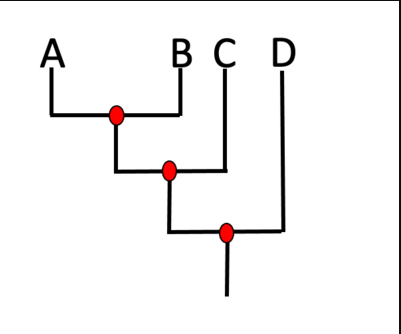
Which lineage is sister to C?
D
B
The lineage that includes A, B, and D
The lineage that includes A and B
The lineage that includes A and B
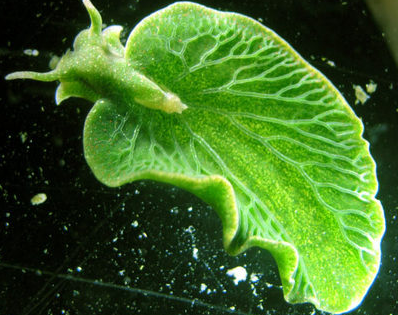
The sea slug Elysia chlorotica is a photosynthetic animal that has chloroplasts! Its chloroplasts originated as free-living green algae. Which level/kind of endosymbiosis does this represent? Use one word to answer.
Secondary
The phylogenetic trees on the slide represent the differing hypotheses that scientists have given for the relationship between the three groups of bryophytes and vascular plants. Among the bryophyte lineages, both mosses and hornworts have stomata, but liverworts do not. Which of the trees would most likely lead us to interpret a single origin of stomata? Select all that apply.
A
B
C
D
E
A,B, and C
Are each of the sperm cells from a single individual human genetically identical?
Yes, because the sperm cells all come from the same individual.
No, because sperm cells are produced by meiosis and thus each is genetically unique.
No, because sperm cells are produced by meiosis and thus each is genetically unique.
Think about the genetic relationship between an adult human and their gametes. How and why is an egg cell genetically different than, say, a skin cell from the same adult? Please choose all of the true statements below:
Gametes are haploid while skin cells are diploid.
Skin cells are haploid while gametes are diploid.
Gametes are genetically identical to the skin cells because they are produced by mitosis.
Gametes are genetically distinct from skin cells because they are produced by meiosis
Options 1 and 4:
Gametes are haploid while skin cells are diploid.
Gametes are genetically distinct from skin cells because they are produced by meiosis

Which of the following stages are diploid (2n)?
B
D
F
G
Options 1 and 2: B and D

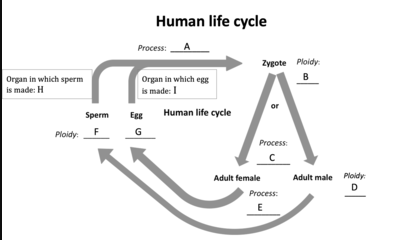
Which of the following stages are haploid (n)?
B
D
F
G
Options 3 and 4: F and G
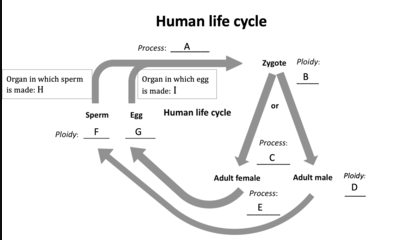
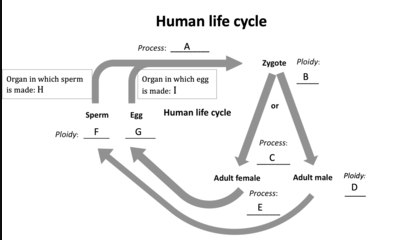
Match the letters in the diagram with the correct process.
Fertilization
Mitosis
Meiosis
Testes
Ovaries
Fertilization- A
Mitosis- C
Meiosis- E
Testes- H
Ovaries-I

What is the genetic relationship between a gametophyte and the gametes it produces?
The gametes differ from the gametophyte but not from one another
The gametophyte and its gametes are genetically identical
The gametophyte and every gamete are each unique
Some, but not all, of the gametes are the same as the gametophyte
Option 2
Explanation:
In plants, gametes are produced through simple mitosis. Without a change in ploidy, independent assortment, or recombination, gametes are genetically identical to the gametophyte that produces them.
What is the genetic relationship between a sporophyte and the spores it produces?
The spores differ from the sporophyte but not from one another
The sporophyte and its spores are genetically identical
The sporophyte and every spore are each unique
Some, but not all, of the spores are the same as the sporophyte
Option 3
Explanation:
Spores are produced by meiosis, so each haploid cell receives half of the genetic material from the diploid cell (spore mother cell) that underwent meiosis. Because of independent assortment and recombination, all four spores resulting from meiosis are genetically unique.
Are each of the spores from a single individual plant genetically identical?
Yes, because the spores all come from the same individual and are produced by mitosis.
No, because spores are produced by meiosis and thus each is genetically unique.
Option 2:
No, because spores are produced by meiosis and thus each is genetically unique.
Are each of the sperm cells from a single individual plant genetically identical?
Yes, because the sperm cells all come from the same individual and are produced by mitosis.
No, because sperm cells are produced by meiosis and thus each is genetically unique.
Option 1:
Yes, because the sperm cells all come from the same individual and are produced by mitosis.
Think about the genetic relationship between a sporophyte and that individual’s spores. How and why is a spore cell genetically different than a cell from the adult sporophyte? Please choose all of the true statements below:
Spores are haploid while sporophyte cells are diploid.
Sporophyte cells are haploid while spores are diploid.
Spores are genetically identical to the sporophyte cells because they are produced by mitosis.
Spores are genetically distinct from sporophyte cells because they are produced by meiosis.
Options 1 and 4

Point to a region of the mature gymnosperm seed that is composed of haploid cells.
Area of nutritive tissue
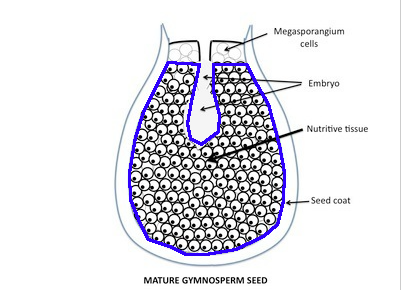

Below are a series of images, each of which depicts a different stage of gymnosperm ovule and seed development. Rank them in chronological order. The first stage has been identified for you here. Black dots represent cell nuclei.
D < B < C < E < A < F < G
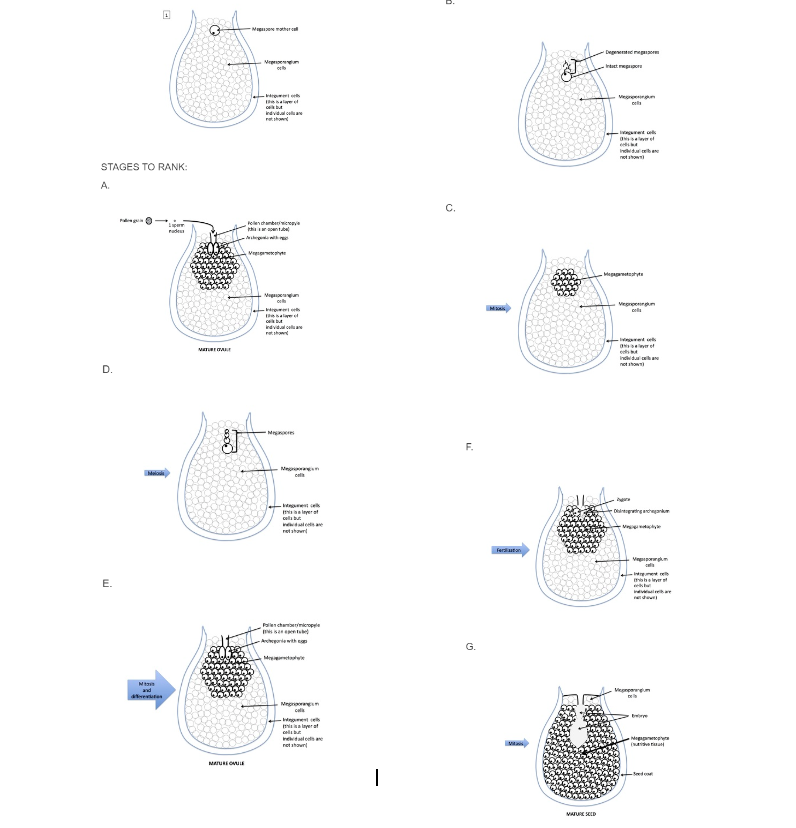
Which of the following statements about gymnosperm seeds is FALSE:
Seeds contain two diploid tissue layers that are not genetically identical.
Seeds consist of three different stages in the alternation of generations life cycle.
Seeds consist of three different genetic "individuals" packaged together.
The nutritive tissue contains genes from the father of the embryo.
Option 4:
The nutritive tissue contains genes from the father of the embryo.
What percentage of genes are shared between the seed coat and the embryo? (Type in numerical digits only.)
50
What percentage of genes are shared between the megagametophyte and the embryo? (Type in numerical digits only.)
50
Describe the movement of water from the spongy mesophyll cells to the atmosphere.
Water evaporates from the surface of the spongy mesophyll cells. Transpiration is when the water vapor passes through the stomata to the atmosphere.
Water moves via transpiration from the surface of the spongy mesophyll cells. Evaporation is when the water vapor passes through the stomata to the atmosphere.
Transpiration and evaporation are both happening at the spongy mesophyll cells.
Option 1:
Water evaporates from the surface of the spongy mesophyll cells. Transpiration is when the water vapor passes through the stomata to the atmosphere.
In leaves, where do where evaporation and transpiration occur? Describe the movement of water from the inside of the leaf to the atmosphere.
Evaporation primarily occurs from the surface of the spongy mesophyll cells. Water evaporates from the surface of the spongy mesophyll cells. The water vapor passes through the stomata to the atmosphere via transpiration.
Transpiration occurs from the surface of the spongy mesophyll cells. Evaporation primarily occurs at the stomata. The water vapor passes through the stomata to the atmosphere via evaporation.
Transpiration and evaporation are happening primarily in the spongy mesophyll. Water travels to the atmosphere from the inside of the leaf via leaf veins.
Option 1:
Evaporation primarily occurs from the surface of the spongy mesophyll cells. Water evaporates from the surface of the spongy mesophyll cells. The water vapor passes through the stomata to the atmosphere via transpiration.
What is the effect of evaporation and subsequent transpiration on the surface tension of the water in the cell walls of the spongy mesophyll cells?
Surface tension on the water in the cell walls will increase.
Surface tension on the water in the cell walls will decrease.
Surface tension on the water in the cell walls will not change.
Option 1:
Surface tension on the water in the cell walls will increase.
In vascular plants, the unbroken column of water from the roots to the highest leaves is kept intact by…?
ATP
Tension
Cohesion
Transpiration
Osmosis
Option 3: Cohesion
It’s a cloudy, rainy day. What do you expect to happen to the rate of water movement through the plant?
It will speed up, because the amount of water available to be absorbed by the roots is increased.
It will speed up, because the rate of transpiration will increase.
It will slow down, because the cohesion among the water molecules will decrease.
It will slow down, because transpiration will decrease due to the lack of a humidity gradient.
Option 4:
It will slow down, because transpiration will decrease due to the lack of a humidity gradient.
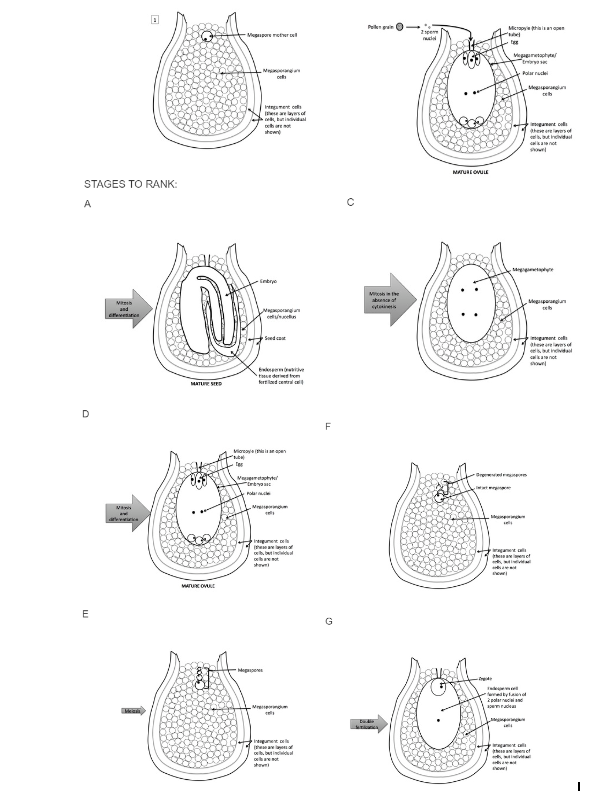
Below are a series of images, each of which depicts of a different stage of angiosperm ovule and seed development. Rank them in chronological order. The first stage has been identified for you here. Black dots represent cell nuclei.
E < F < C < D < B < G < A
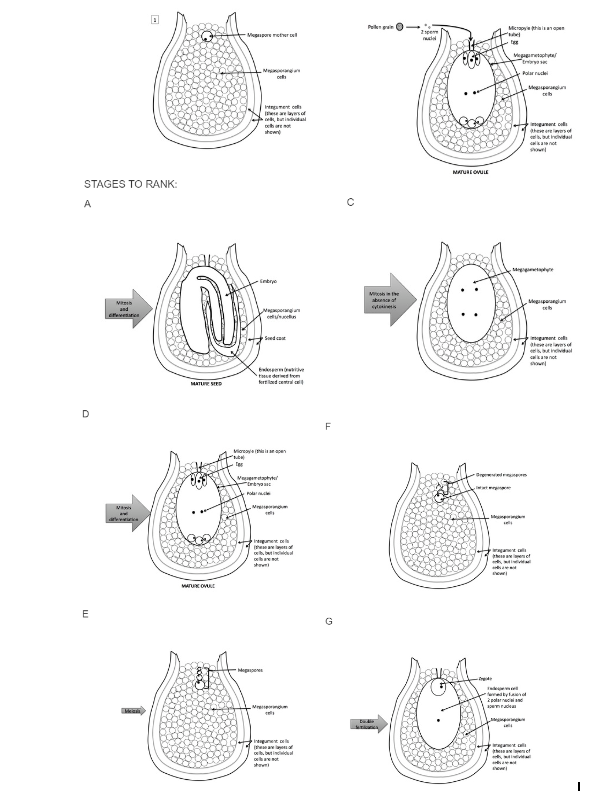
Which of the following best defines “tropism”?
a cellular response to external stimuli that results in a structural change.
growth of the plant in response to light.
a cellular response to internal stimuli that results in a structural change.
Option 1:
a cellular response to external stimuli that results in a structural change.
Auxin causes a plant to grow larger by:
Stimulating cells to stretch and become larger.
Causing an asymmetric increase in the length of the stem or root.
Stimulating the apical meristem to produce new cells.
Causing an increase in the speed of cell divisions and maturation.
Option 1:
Stimulating cells to stretch and become larger.
Which are correct regarding expansins?
Expansin activity is stimulated by the decrease in pH of the cell wall.
Expansin activity increases due to the decrease in turgor pressure of the cell.
Expansins loosen the cell wall to allow elongation.
Expansin activity results in a change in flow of auxin in the shoot tip.
Expansins are sensitive to light and cause the shoot tip to bend.
Options 1 and 3:
Expansin activity is stimulated by the decrease in pH of the cell wall.
Expansins loosen the cell wall to allow elongation.
Refer to the diagram of the shoot tip below. The arrow in the diagram indicates the direction of the sun's rays falling upon the shoot tip. Draw an arrow indicating the direction in which you expect the shoot tip to grow.
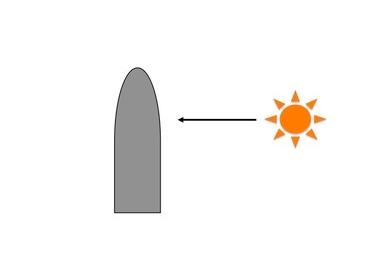
The bending of a plant towards sunlight is the result of:
differential growth by a plant in response to gravity pulling on it.
elongation caused by increased auxin concentration on the shaded side of the plant.
decrease in turgor pressure caused by increased transpiration of water vapor into the atmosphere.
rapid division of cells on the side of the plant exposed to light.
Option2:
elongation caused by increased auxin concentration on the shaded side of the plant
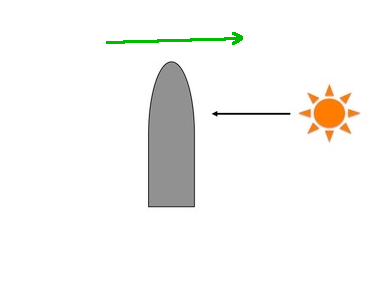
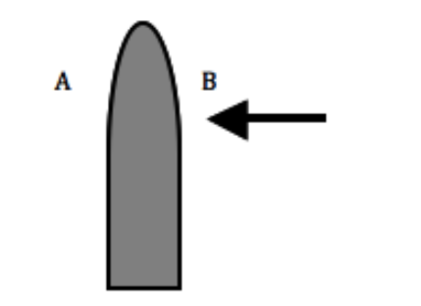
Refer to the diagram of the shoot tip. The sun is shining on this shoot tip in the direction of the arrow. Which of the following do you predict will happen next?
Auxin concentration will increase on the sunny side, causing the cell walls to elongate on the sunny side (B), resulting in a bend toward the sun.
Auxin concentration will increase on the shady side, causing the cells to contract on the shady side (A), resulting in a bend toward the sun.
Auxin will accumulate at the very tip, causing those cells to divide, resulting in growth toward the sun (B).
Auxin concentration will increase on the shady side, causing the cell walls to loosen and cells to elongate on the shady side (A), resulting in a bend toward the sun.
Auxin concentration will decrease on the sunny side, causing the cell walls to contract on the sunny side (B), resulting in a bend toward the sun.
Option 4:
Auxin concentration will increase on the shady side, causing the cell walls to loosen and cells to elongate on the shady side (A), resulting in a bend toward the sun.
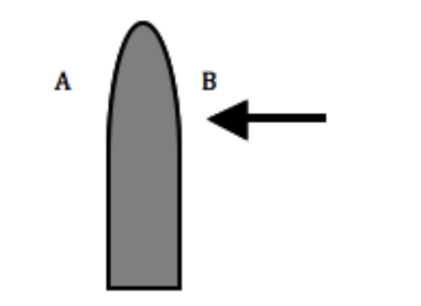
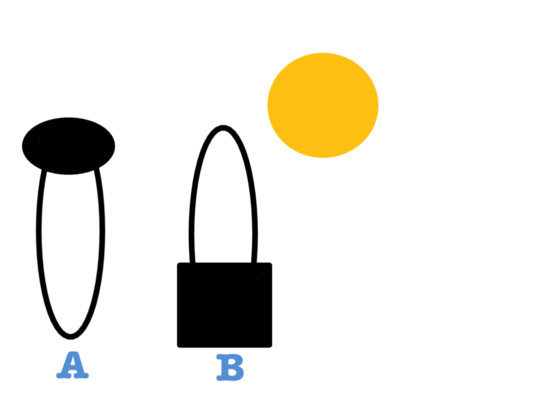
The plant on the left (A) has an opaque (light cannot get through it) cap that only covers the coleoptile (shoot tip), while the plant on the right (B) has an opaque band covering 2 cm away from the shoot tip. Predict what would happen to each plant based on the concepts of phototropism.
Shoot tips A and B will grow straight upwards with no bend.
Shoot tip A will grow straight upwards with no bend, while shoot tip B will bend toward the light (right).
Shoot tip A will bend toward the light (right), while shoot tip B will grow straight upwards with no bend.
Shoot tips A and B will bend toward the light (right).
Option 2:
Shoot tip A will grow straight upwards with no bend, while shoot tip B will bend toward the light (right).
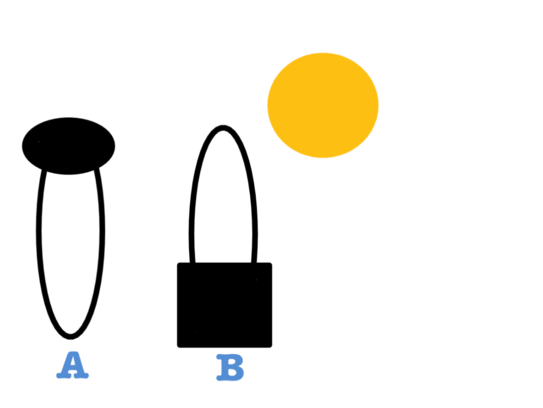
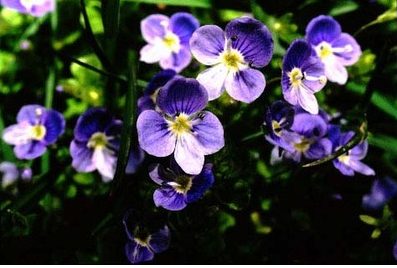
What is the most likely pollinator of a large, bright blue flower, sweet smelling, with yellow spots leading to the center, that is held horizontally from the stem?
Beetles
Flies
Wind
Bees
Butterflies
Option 4: Bees
[Choose all that apply]
"Secondary metabolites" in plants are those chemical substances that:
protect the plant from fungi and bacteria
deter herbivory by insects and other animals
enable the plant to successfully obtain carbon and other nutrients from the soil
attract human interest due to medicinal, recreational, and flavoring properties, among others.
are considered essential to the everyday, ordinary functioning of any plant, no matter the species.
Options 1, 2, and 4:
protect the plant from fungi and bacteria
deter herbivory by insects and other animals
attract human interest due to medicinal, recreational, and flavoring properties, among others.
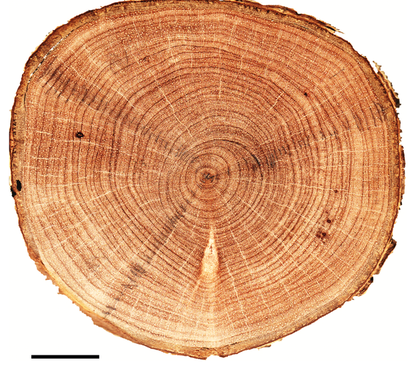
Place a dot where the oldest wood is found.
In the center
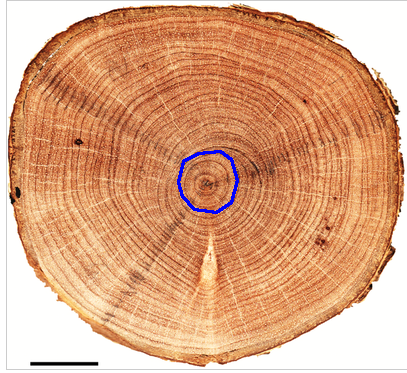
Two of the following characteristics are different between CAM and C4 photosynthesis, and two are shared. Which are shared between the two pathways?
the timing of when stomata are opened.
the use of malate as a intermediate in which CO2 can be stored and/or moved.
the anatomical arrangement of photosynthetic cells in leaves.
an adaptation to xeric climates
Options 2 and 4:
the use of malate as a intermediate in which CO2 can be stored and/or moved.
an adaptation to xeric climates
[Choose all that apply]
Which phenomenon(a) best explains the fact that, in similar habitats, similar growth forms and similar physiological adaptations have evolved repeatedly in unrelated plant clades?
mutation
genetic drift
convergent evolution
hybridization
adaptation
natural selection
Options 3, 5, and 6:
convergent evolution
adaptation
natural selection
Many plants store sugar in the form of starch in underground structures (think potatoes or beets). In the spring new leaves must be formed before the plant can begin photosynthesizing again. Which statement below offers a plausible explanation of the function of phloem in plants like potatoes and beets?
The roots are source cells in the summer and winter but not in the spring and fall.
The leaves are source cells during the summer and the roots are the source cells in the early spring.
The flow of sugars is in the direction of sink to source.
When the leaves are forming in the spring, phloem flow stops.
Phloem must flow from the roots in this species, to supply the leaves with sugars all year round.
Option 2:
The leaves are source cells during the summer and the roots are the source cells in the early spring.
Which statement best describes systemic acquired resistance?
It is a localized response to a pathogen.
It is production of new receptor proteins.
It is an increase in gene expression.
It is overproduction of general immune chemicals.
It is a general, non-localized increase in pathogen resistance.
Option 5:
It is a general, non-localized increase in pathogen resistance.
Some plants are able to trigger immune responses in neighboring plants before those plants have been attacked. To do this, they produce
phytoalexins.
volatile organic compounds (VOCs).
compounds that trigger local responses.
compounds that signal hypersensitve response.
compounds that trigger phytoalexin production.
Option 2: volatile organic compounds (VOCs)
Which is illustrated in the image below?

The plant is decaying because of a lack of immune response
Systemic response indicated by the discoloration
Innate immunity which directly attacks pathogen
Hypersensitive response indicated by the necrotic lesions
Option 4:
Hypersensitive response indicated by the necrotic lesions